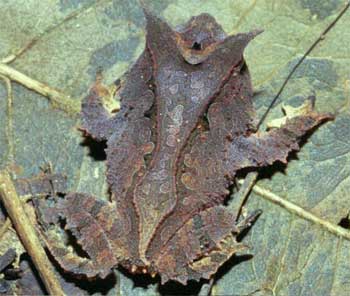Brazil: Dwarf Woodpecker, Legless Lizard, and 12 Other New Species Found
Posted by: Loren Coleman on April 29th, 2008
Researchers discovered a legless lizard and a tiny woodpecker along with 12 other suspected new species in Brazil’s Cerrado, one of the world’s 34 biodiversity conservation hotspots.

An example of Picumnus but not the new species.
The Cerrado’s wooded grassland once covered an area half the size of Europe, but is now being converted to cropland and ranchland at twice the rate of the neighboring Amazon rainforest, resulting in the loss of native vegetation and unique species.
An expedition comprising scientists from Conservation International (CI) and Brazilian universities found 14 species believed new to science – eight fish, three reptiles, one amphibian, one mammal, and one bird – in and around the Serra Geral do Tocantins Ecological Station, a 716,000-hectare (1,769,274-acre) protected area that is the Cerrado’s second largest.
An example of Bachia sp. but not the new species.
The lizard, of the Bachia genus, resembles a snake due to its lack of legs and pointed snout, which help it move across the predominantly sandy soil formed by the natural erosion of the escarpments of the Serra Geral. Other suspected new species include a dwarf woodpecker (genus Picumnus) and horned toad (genus Proceratophrys).

An example of Proceratophrys sp. but not the new species.
“It’s very exciting to find new species and data on the richness, abundance, and distribution of wildlife in one of the most extensive, complex, and unknown regions of the Cerrado,” said CI biologist Cristiano Nogueira, the expedition leader. “Protected areas such as the Ecological Station are home to some of the last remaining healthy ecosystems in a region increasingly threatened by urban growth and mechanized agriculture.”
The team also recorded several threatened species such as the hyacinth macaw, marsh deer, three-banded armadillo (tatu-bola), the Brazilian merganser, and the dwarf tinamou among more than 440 species of vertebrates documented during the 29-day field expedition.
Comprising 21 percent of Brazil, the Cerrado is the most extensive woodland-savanna in South America. Large mammals such as the giant anteater, giant armadillo, jaguar and maned wolf struggle to survive in the fast-changing habitat also know as Brazil’s breadbasket.
The expedition included 26 researchers from the University of São Paulo and its Museum of Zoology; the federal universities of São Carlos and Tocantins; and CI-Brazil. It was funded by the O Boticário Foundation for Conservation of Nature, with the support of the NGO Pequi–Pesquisa e Conservação do Cerrado (Research & Conservation of the Cerrado).
“The geographic distribution of some of the species registered is restricted to the area of the ecological station; thus their survival depends on the good management of the protected area and its immediate surroundings,” said Luís Fabio Silveira, of the Department of Zoology of the University of São Paulo. “From the survey we can obtain data concerning the anatomy, reproductive biology, life cycle, and distribution of the species, all of which help us in future conservation programs.”
Final results of the study, including the formal description of new species, will be used to support the development of a management plan for the Ecological Station, which was created in 2001.
“We need to know our protected areas better, especially the ecological stations whose principal objective is to generate scientific knowledge of Brazilian biodiversity, so little studied and already so severely threatened,” Nogueira said. “Unfortunately, extensive areas of the Cerrado, like the Ecological Station, are becoming increasingly rare, thus making the data collected even more important. Above all, it is necessary to know to conserve.”
Legless Lizard Among Newly Discovered Species
About Loren Coleman
Loren Coleman is one of the world’s leading cryptozoologists, some say “the” leading living cryptozoologist. Certainly, he is acknowledged as the current living American researcher and writer who has most popularized cryptozoology in the late 20th and early 21st centuries.
Starting his fieldwork and investigations in 1960, after traveling and trekking extensively in pursuit of cryptozoological mysteries, Coleman began writing to share his experiences in 1969. An honorary member of Ivan T. Sanderson’s Society for the Investigation of the Unexplained in the 1970s, Coleman has been bestowed with similar honorary memberships of the North Idaho College Cryptozoology Club in 1983, and in subsequent years, that of the British Columbia Scientific Cryptozoology Club, CryptoSafari International, and other international organizations. He was also a Life Member and Benefactor of the International Society of Cryptozoology (now-defunct).
Loren Coleman’s daily blog, as a member of the Cryptomundo Team, served as an ongoing avenue of communication for the ever-growing body of cryptozoo news from 2005 through 2013. He returned as an infrequent contributor beginning Halloween week of 2015.
Coleman is the founder in 2003, and current director of the International Cryptozoology Museum in Portland, Maine.










As the world is desperate for alternative fuels, the brazilians are turning their rain forests into oil palm fields. On the positive side we are finding more new species, too bad that the minute they are discovered, they have to be put in the “endangered” list 🙁
BTW, the brazilians are trying to make new laws to restrict the access of foreigners to the Amazon. I don’t know if they are either afraid of Big Pharma corporations looking to profit from new biological prospects for new medicines… or maybe they’re just tired of all the “gringos” going to the jungle to have a taste of ayahuasca brew 😉
Gringos? Be careful my Mexican friend. 🙂
What company owns some of the largest tracts of the Amazon rainforest? It is the Mitsubishi Corporation.
Japan’s average tropical timber import of 11 million cubic meters annually is termed “gluttonous” by critics.
Wow! some pretty scary stats there. And here I am designing a “lounge veranda” for some luxury apartments in Acapulco, which will be made of wood. What kind of wood? the tropical and cheap kind of course, and whether it comes from a sustainable forest is something my employer doesn’t give a hoot about.
Waiting for the karma police to take me away, I guess 🙁
I am no longer amazed at the new critters that crop up from time to time! I guess we humans don’t know every thing about this planet and its life forms yet….hmmmmm is Bigfoot next?
This article highlights an important issue. When many people hear the term “habitat loss” they autmatically think of tropical rainforest. This in itself is no bad thing, as we all know the plight that the worlds rainforests are in. However, it’s important to realise, as the above article informs us, that other habitats are equally under threat. Grassland habitats in particular are in a perilous situation as they are so easily turned into farmland. While the basic nature of the landscape isn’t altered much (especially in the case of cattle farming), the impact that human encroachment has is dangerous. Inevitably, the balance of the environment is altered and this, combined with “population control” (read: hunting) causes huge decreases in the populations of predators, while overgrazing from domestic cattle results in a de-population of herbivores. While smaller creatures often seem to initally benefit, we have no real idea of the long term effects of this kind of farming on the eco-system. Arable farming of coruse causes even more direct damage to the eco-system, with the added ingredient of chemical pesticides. This is happening on a large scale in southern and eastern Africa and, as mentioned above, various parts of South America, and more awareness needs to be raised.
As red pill junkie said, it seems that the rate at which we discover new speicies runs oddly in tandem with the rate at which speicies are added to the endangered list. As long as we contiunue to blindly ruin habitats, it’s not going to change.
I hope they are setting aside some reserves, and taking up the practice of hedgerows and windbreaks.
As we’ve seen in America, if the animals don’t go extinct, they come back in about 100 years, and that is without the above practices.